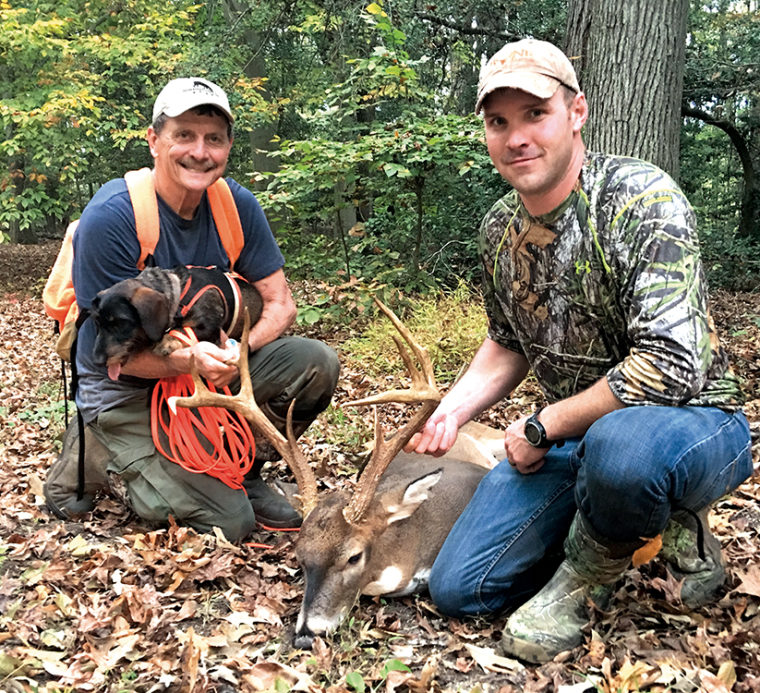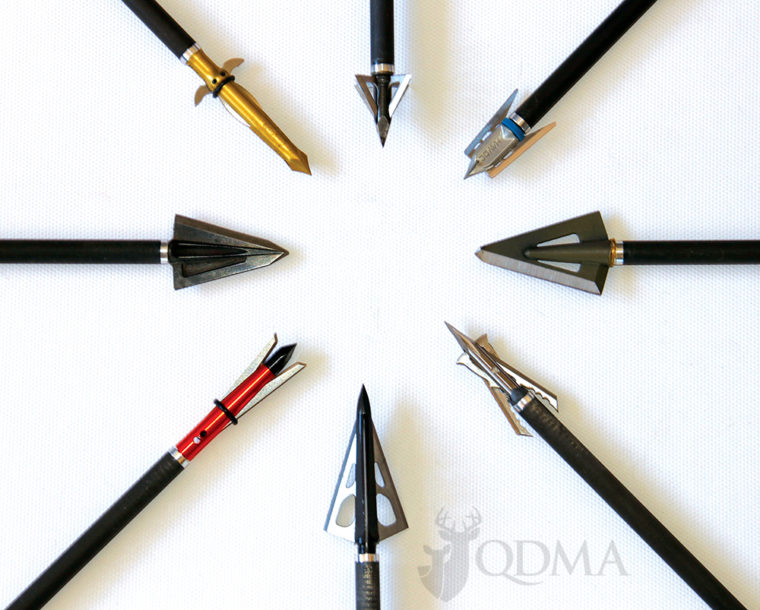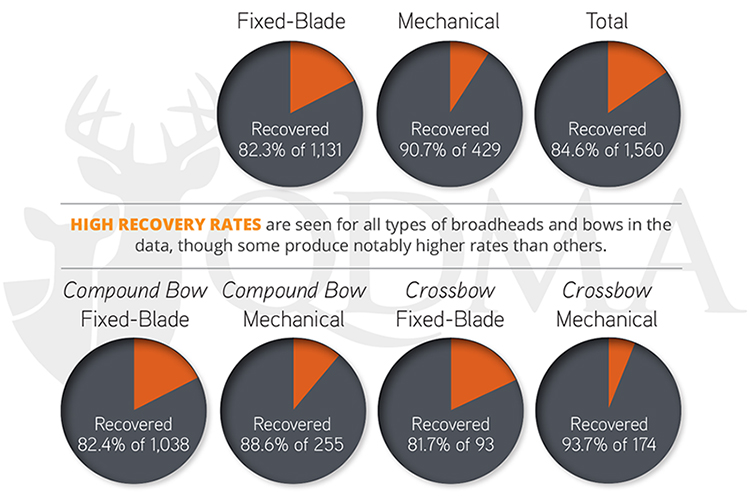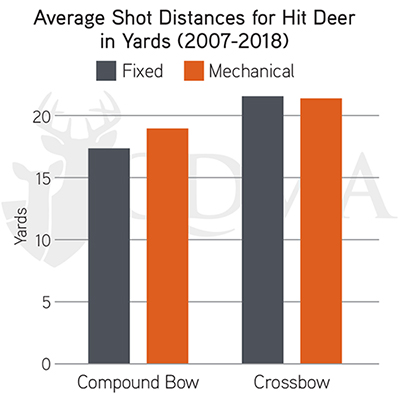For the past 30 years, I’ve helped bowhunters track white-tailed deer on the Naval Support Facility Indian Head, a military installation on the Potomac River just south of Washington, D.C., and in the surrounding southern Maryland counties. After the Natural Resources Office (NRO) on the Navy Base allowed bowhunters to use mechanical broadheads for the first time in 2007, I developed a dislike for mechanicals. I was getting tracking calls that involved poor penetration and unrecovered deer. In 2013, I decided it was time to use the deer recovery data from the Navy Base’s bowhunting program to prove mechanicals were a bad idea for bowhunting. I published A Comparative Study on the Effectiveness of Fixed-blade and Mechanical Broadheads in 2014, and the data revealed that mechanicals were not only just as good as fixed-blades, they were even better.
Fast forward to 2019, and six more years of recovery data have verified the original findings. This article, first published in Quality Whitetails magazine, outlines and updates the efforts undertaken to determine the indeterminable in the fixed-blade vs. mechanical broadhead debate.
Fixed-blade vs. Mechanical Broadheads
Internet discussions on the merits and limitations of fixed-blade and mechanical broadheads are largely based on personal experiences and opinions. One common theme in these discussions is that accuracy is paramount. If a bowhunter hits a deer in the heart/lung area, the choice of broadhead likely doesn’t matter, and deer recovery is almost certain. But the deer recovery rates of bowhunters are not 100%. After all, the adrenaline rush of having a deer in close range may ruin one’s shooting form or deer may “jump the string” – react to the sound of the arrow or its release before the arrow arrives – just a few of many reasons why bowhunters may not hit a deer where they had intended. Given a less-than-ideal shot placement, other matters come into play such as how long to wait before tracking, and did the arrow get full penetration. With so many variables affecting deer recovery, how can you resolve broadhead tradeoffs for accuracy, cutting diameter, penetration and reliability with scientific objectivity?
Methodology
Many people have characterized relative broadhead performance by shooting at materials like plywood and ballistic gel. While these tests are hopefully meaningful in some aspect to killing deer, they do not address a critical issue: Did you find your deer? Surveying bowhunters as to how many deer they did and did not recover has its limitations, for it is a well-known human trait to deny shameful behavior. The bowhunting program on the Indian Head Navy Base documented hunter success and failure, so I did not have to rely on selective memories. The rock-solid database includes details on over 40,000 hours of bowhunting effort gathered over a span of 30 hunting seasons.
Deer Recovery Data
The Indian Head Navy Base is an explosives manufacturing and testing facility about 30 miles south of Washington D.C. Its 3,000 acres are also home to a whitetail herd that was once estimated at 200 deer per square mile in the 1980s. The Navy Base used sharpshooters intermittently to reduce the deer population back then. Bowhunting was proposed as a controversial alternative to sharpshooters. I was one of several hunters who helped set-up the bowhunting program. Safety was a primary issue – how could we quickly locate and account for all hunters if there was a Base emergency? Also, how could we document and prove the bowhunting program would operate without “excessive” wounding losses?
In 1989, the Navy Base approved a structured bowhunting program that required monitoring and documenting all hunter effort. All bowhunters (individuals affiliated with the Base, as there is no public access) first had to pass a State-approved Bowhunter Education Class and an annual pre-season shooting qualification test with broadheads. Mechanical broadheads were not allowed at the time due to concerns with wounding losses. Bowhunters signed in to hunt specific sites and had to sign out by one hour after sunset. Bowhunters notified the “Hunt Captain” – a trusted agent of the NRO – if they hit a deer. The Hunt Captain assisted with any tracking that went outside the assigned hunting area or after hours. All recovered deer were taken to a check station where the Hunt Captain recorded live/dressed weight and other biological data in a Harvest Log. Each hunter submitted a daily data sheet to the NRO that included equipment used and whether deer were recovered. Shot distances were added to the data sheet in 2007.

Nate Warren, who is on active duty with the U.S. Navy at the Naval Support Facility Indian Head, Maryland, killed this buck on base, one of 1,320 recovered deer in the featured study. Left: Study author Andy Pedersen and Ruby, Andy’s blood-tracking dog who helped locate Nate’s buck.
Results and Discussion
Hunting on the Indian Head Navy Base could be characterized as “low pressure” – an average of six bowhunters participate on any given day. For the 1989 through the 2018 seasons, 181 bowhunters recovered 1,320 of 1,560 hit deer (84.6%). Compiled hunter data sheets provided the bow type (compound bow or crossbow) and the broadhead type (fixed-blade or mechanical) that were used for each hit deer.
For the 1989 through the 2006 seasons, bowhunters who then could use only fixed-blade broadheads recovered 746 of 908 hit deer (82.2%). For the 2007 through 2018 seasons bowhunters who used fixed-blades recovered 185 of 223 hit deer (83.0%). Since these recovery rates are similar, there is no reason not to combine all fixed-blade broadhead recovery data in order to improve the “statistical confidence” of the measure. Accordingly, bowhunters who used fixed-blades for the 1989 through 2018 seasons recovered 931 of 1131 hit deer (82.3%). Bowhunters who used mechanicals for the 2007 through 2018 seasons recovered 389 of 429 hit deer (90.7%).
Bowhunters who used mechanicals had a wounding rate of 9.3%, nearly one-half the 17.7% wounding rate for bowhunters who used fixed-blade broadheads.
The pie charts above also show the recovery rates for both compound bow and crossbow users. (Maryland removed crossbow restrictions in 2010. Crossbow users now account for about half the annual deer harvest on the Navy Base). The improvements to the deer recovery rates for bowhunters using mechanical broadheads with either compound bows or with crossbows are statistically significant. However, the differences in recovery rates between compound bow and crossbow users with respect to broadhead choice are not statistically significant. Note the average recovery rates for bowhunters using fixed-blade broadheads with compound bows (82.4%) or with crossbows (81.7%) are nearly the same.
The relative shot distances taken do not appear to be a factor in the assessment of broadhead effectiveness. The chart below shows the average shot distances by bow and broadhead type. The differences in average shot distances for the respective subgroups are not statistically significant. The average shot distance for 633 hit deer is 19.1 yards.
Since this was an observational study (the events occurred before the analysis), we can only say the use of mechanicals is associated with higher deer recovery rates. Statistical tests indicate it is unlikely mechanicals performed better than fixed-blades due to random chance. I do not have data that can explain why the recovery rates with mechanicals were better than the recovery rates with fixed-blades. You can speculate the smaller flight profile of mechanicals promotes better accuracy, or that their larger cutting diameter makes for better/shorter blood trails, or all the above.
Conclusion and Recommendations
The considerable number of archery-hit deer in the database helped average out the effects of uncontrolled variables such as hunter skill, shot angle and tracking effort. It is difficult to imagine how any of these factors could have favored deer recovery for one broadhead type or the other. Therefore, I conclude that broadhead choice really does matter. However, like many others I feel that accuracy with a bow requires confidence in your equipment. If a bowhunter uses a compound bow and has had satisfying success with fixed-blade broadheads, then they should probably stay with fixed-blades. If a compound bow user wants to experiment with mechanicals, then they shouldn’t worry about oft-expressed concerns with reliability or penetration. These concerns are apparently not significant enough to have an adverse effect on deer recovery – on average! However, the benefit of mechanicals to crossbow users is rather substantial. I recommend that bowhunters with crossbows consider using mechanical broadheads.
Editor’s Note: NDA learned of Andy’s study when he first shared it with the public in 2014, and we published an article about the study. A common question for Andy at the time: How does he know hunters aren’t declining to report deer they hit and failed to recover? For several reasons, Andy believes this probably never happens. First, permission to hunt this base is highly exclusive and desirable, and you can lose it if you don’t follow the rules. Also, because of base safety and security requirements, hunters are not allowed to track deer outside their designated stand sites without notifying the Hunt Captain. Finally, hunters almost always ask for help with blood-trailing because recovery is so important. If it’s a doe, you want the credit for earn-a-buck rules. If it’s a buck, it’s a nice one due to base antler requirements. Given the rules, the incentives, and the close nature of the base and hunting communities, Andy said it would be very difficult to hit and lose a deer on base without anyone else knowing it.
About the Author
Andy Pedersen of Nanjemoy, Maryland is an NDA member who retired as a senior engineer from the Naval Support Facility Indian Head. Andy helped establish the Base’s bowhunting program for managing the deer population. Andy is also a member of United Blood Trackers, which promotes conservation through recovery of big game with trained tracking dogs.


